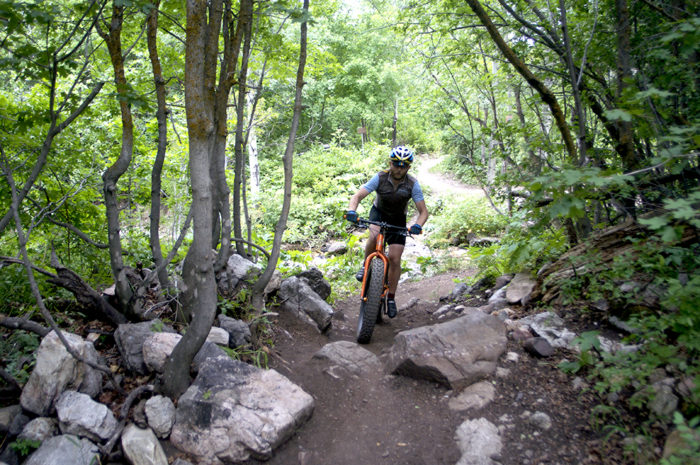Chances are if you haven’t already seen a fat bike here in St. Louis, you soon will. That’s what we’re hearing from local bike shops about the latest trend to hit the trails. And if you have seen one, wipe that smirk off your face. While they may be clown-like in appearance, these mean machines are capable of gobbling up almost any terrain, from snow and sand to rocks and mud, so there are fewer limits to where and when you can ride.
“A fat bike opens up possibilities. On a day when you ordinarily can’t ride, now you can,” said Mike Weiss, owner of Big Shark Bicycle Company. “This has been a very cold and icy winter, so here and in the northern climates, the fat bike is actually practical.”
Practical and even preferred among a growing set of riders. The Midwest has become the hub for fat biking in North America, with growing fat bike race series in Minnesota, Wisconsin and Michigan. Quality Bicycle Products, which makes the popular Surly and Salsa brands of fat bikes, is based in Minneapolis.
Back here in Missouri, the “next big thing” slow-rolled onto the scene about 10 years ago as a novelty. “We first became interested when two of our customers, Aaron Fanetti and Vanessa Mackenzie, competed in the Iditabike race in Alaska,” said Weiss. The mountain biking endurance race, an offshoot of the famous Iditarod dog-sled race from Anchorage to Nome, was notoriously hard on standard mountain bikes with two- or two-and-a-half-inch tires
Experimentation ensued, with the eventual result being the Surly Pugsely, the first mass-produced fat bike. Its four-inch tires were able to “float” over hard-packed snow without sinking in, and because they used very low air pressure, the tires provided natural suspension and a massive footprint for extra traction. Today’s fat bikes, though more mainstream than the original Pugsley, follow the same principles.
“I got my first fat bike about eight or nine years ago,” said Cody Jones, manager of Ballwin Cycles. “The early models were heavy, weighing in the 40s [pounds]. The newer ones are as light as the 20s, like a regular mountain bike. The geometry has also changed some, so they handle better and are quicker.”
Jones can often be found at Greensfelder Park in Eureka, where the hilly, rocky trails offers a good opportunity to show off his fat bike’s enhanced grip and control. “Tire pressure is very important for the best ride and traction,” he said. “I ride at four to five psi in the winter and six or seven in the summer.”
As well as being mindful of tire pressure, fat bike owners also need to be aware that these rigs, while growing in popularity, are not entirely conventional. Tubes, tires, wheels and other equipment are likely going to be a bit harder to acquire.
But accessibility is getting better. More manufacturers are introducing fat bikes than ever before, including Trek and Specialized, which have released their own versions for 2014.
“You can get an entry-level model for as low as a thousand dollars,” said Jones. “Standard is more economical, but we can do whatever someone wants, down to the smallest custom detail.” Ballwin Cycles currently stocks Surly and Salsa fat bikes, “and we’re selling out of them,” Jones said.
Big Shark sells Surly, Salsa and Kona, as well as a new Cannondale model. “Surly is the durable, in-the-trenches steel bike line. Salsa bikes are a bit higher-end and use other frame materials: carbon fiber, titanium and aluminum,” said Weiss. “I think the demand is increasing, and since they actually are great for their intended purpose and are fun, they should be around for a long, long while.
Jones agreed. “It’s another arrow in the quiver,” he said. “The bikes and brands are becoming more established, more suited for the masses.”
In fact, the next evolution of the fat bike is already here—and even more suited for everyday use. The “29+” combines the 29-inch wheel diameter of many of today’s preeminent mountain bikes with three-inch-wide tires. The increased wheel diameter, three inches larger than the standard fat bike, enhances the roll dynamics while the increased tire width provides some of the improved traction and ride characteristics of a fat bike.
Whatever the future fat bike looks like, it seems the big-wheeled cycles are here to stay. And that’s good news for those who want to extend their season and open up new horizons in two-wheel adventure.
Author: Brad Kovach is the editor of Terrain Magazine.


Nice read. I snickered at these monster bikes before the winter of 2014. Now, I wish I had bought one last fall.
Fast forward 6 years, fat tire bikes are quite popular due to the fact that they provide stability with their increased surface area for traction and the ability to overcome any obstacle. A fat tire mountain bike with a full suspension is a bike I’ll never get off from.